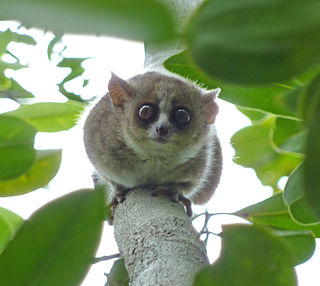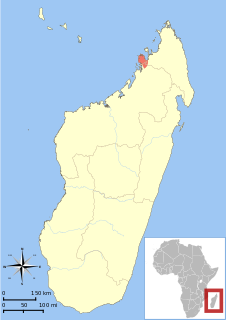 W
WLemurs are mammals of the order Primates, divided into 8 families and consisting of 15 genera and around 100 existing species. They are native only to the island of Madagascar. Most existing lemurs are small, have a pointed snout, large eyes, and a long tail. They chiefly live in trees (arboreal), and are active at night (nocturnal).
 W
WLemurs are strepsirrhine primates, all species of which are endemic to Madagascar. They include the smallest primate in the world, Madame Berthe's mouse lemur, which weighs 30 grams (1.1 oz), and range up to the size of the indri, which can weigh as much as 9.5 kilograms (21 lb). However, recently extinct species grew much larger. As of 2010, five families, 15 genera, and 101 species and subspecies of lemur were formally recognized. From 2000 through 2008, 39 new species were described and nine other taxa resurrected. By 2014, the number of species plus subspecies recognized had increased to 113; of the 105 species then known, the IUCN classified 24 as critically endangered, 49 as endangered, 20 as vulnerable, three as near threatened, three as least concern and four as data deficient; two were yet to be evaluated.
 W
WThe Lemur Conservation Foundation (LCF) is a non-profit organization dedicated to the preservation and conservation of the primates of Madagascar through managed breeding, scientific research, education, and art. It was founded in 1996 by Penelope Bodry-Sanders under the advisement of paleoanthropologist Ian Tattersall. The foundation's reserve in Myakka City, Florida, United States, is home to more than 50 lemurs of several different species, most of which are critically endangered or endangered, including ring-tailed lemurs, red ruffed lemurs, mongoose lemurs, collared brown lemurs, common brown lemurs and Sanford's lemurs.
 W
WLemurs of Madagascar is a 2010 reference work and field guide for the lemurs of Madagascar, giving descriptions and biogeographic data for the known species. The primary contributor is Russell Mittermeier, president of Conservation International, and the cover art and illustrations were drawn by Stephen D. Nash. Currently in its third edition, the book provides details about all known lemur species, general information about lemurs and their history, and also helps travelers identify species they may encounter. Four related pocket field guides have also been released, containing color illustrations of each species, miniature range maps, and species checklists.
 W
WThe Amber Mountain fork-marked lemur, also known as the Montagne d'Ambre fork-crowned lemur or Tanta, is a small primate, and like the other lemurs, can only be found on the island of Madagascar. The species is named after the Amber Mountain National Park where they are found.
 W
WThe aye-aye is a long-fingered lemur, a strepsirrhine primate native to Madagascar with rodent-like teeth that perpetually grow and a special thin middle finger.
 W
WThe black-and-white ruffed lemur is an endangered species of ruffed lemur, one of two which are endemic to the island of Madagascar. Despite having a larger range than the red ruffed lemur, it has a much smaller population that is spread out, living in lower population densities and reproductively isolated. It also has less coverage and protection in large national parks than the red ruffed lemur. Three subspecies of black-and-white ruffed lemur have been recognized since the red ruffed lemur was elevated to species status in 2001.
 W
WThe Cheirogaleidae are the family of strepsirrhine primates containing the various dwarf and mouse lemurs. Like all other lemurs, cheirogaleids live exclusively on the island of Madagascar.
 W
WChiromyiformes is an order of strepsirrhine primates that includes the aye-aye from Madagascar and its extinct relatives.
 W
WCoquerel's giant mouse lemur, also known as Coquerel's dwarf lemur or the southern giant mouse lemur, is a small nocturnal lemur endemic to Madagascar. This species can be found in parts of the Madagascar dry deciduous forests.
 W
WThe Duke Lemur Center is an 85-acre (34 ha) sanctuary for rare and endangered strepsirrhine primates, located at Duke University in Durham, North Carolina. It is the largest sanctuary for strepsirrhine primates in the world.
 W
WLemurs, primates belonging to the suborder Strepsirrhini which branched off from other primates less than 63 million years ago, evolved on the island of Madagascar, for at least 40 million years. They share some traits with the most basal primates, and thus are often confused as being ancestral to modern monkeys, apes, and humans. Instead, they merely resemble ancestral primates.
 W
WFork-marked lemurs or fork-crowned lemurs are strepsirrhine primates; the four species comprise the genus Phaner. Like all lemurs, they are native to Madagascar, where they are found only in the west, north, and east sides of the island. They are named for the two black stripes which run up from the eyes, converge on the top of the head, and run down the back as a single black stripe. They were originally placed in the genus Lemur in 1839, later moved between the genera Cheirogaleus and Microcebus, and given their own genus in 1870 by John Edward Gray. Only one species was recognized, until three subspecies described in 1991 were promoted to species status in 2001. New species may yet be identified, particularly in northeast Madagascar.
 W
WThe giant mouse lemurs are members of the strepsirrhine primate genus Mirza. Two species have been formally described; the northern giant mouse lemur and Coquerel's giant mouse lemur. Like all other lemurs, they are native to Madagascar, where they are found in the western dry deciduous forests and further to the north in the Sambirano Valley and Sahamalaza Peninsula. First described in 1867 as a single species, they were grouped with mouse lemurs and dwarf lemurs. In 1870, British zoologist John Edward Gray assigned them to their own genus, Mirza. The classification was not widely accepted until the 1990s, which followed the revival of the genus by American paleoanthropologist Ian Tattersall in 1982. In 2005, the northern population was declared a new species, and in 2010, the World Wide Fund for Nature announced that a southwestern population might also be a new species.
 W
WThe greater bamboo lemur, also known as the broad-nosed bamboo lemur and the broad-nosed gentle lemur, is the largest bamboo lemur, at over five pounds or nearly 2.5 kilograms. It has greyish brown fur and white ear tufts, and has a head-body length of around one and a half feet, or forty to fifty centimeters. They have relatively long tails and long back legs for leaping vertically amongst the trees of their forest habitat. It feeds almost exclusively on the bamboo species of Cathariostachys madagascariensis, preferring the shoots but also eating the pith and leaves. It is unknown how their metabolism deals with the cyanide found in the shoots. The typical daily dose would be enough to kill humans. Greater bamboo lemurs occasionally consume fungi, flowers, and fruit. Its main food source is bamboo and it is the main reason why it has become critically endangered. Areas with high density of bamboo have major human disturbances, where humans cut or illegally cut down bamboo. Its only confirmed predators are the fossa and the bushpigs, but raptors are also suspected. Its current range is restricted to southeastern Madagascar, although fossils indicate its former range extended across bigger areas of the island, including as far north as Ankarana. Some notable parts of the current range are the Ranomafana and Andringitra National Parks.
 W
WThe hairy-eared dwarf lemur, or hairy-eared mouse lemur, is one of the most scarcely known lemurs. A. trichotis is a nocturnal lemur that is endemic to Madagascar. It was originally named by Dr. Albert Günther in 1875 as Cheirogaleus trichotis as part of the Cheirogaleidae family, or the dwarf lemurs. However, in 1967 Petter-Rousseaux and Petter reassigned the lemur to its own genus and is the now only member of the genus Allocebus. The hairy-eared dwarf lemur was thought to be extinct until its rediscovery in 1989 in a northeastern primary lowland rainforest. The population of these mammals is shown to be severely decreasing and largely fragmented throughout Northern and Eastern Madagascar rainforests; most likely due to hunting, trapping, slash-and-burn agriculture as well as habitat fragmentation.
 W
WThe Indriidae are a family of strepsirrhine primates. They are medium- to large-sized lemurs, with only four teeth in the toothcomb instead of the usual six. Indriids, like all lemurs, live exclusively on the island of Madagascar.
 W
WIsland of Lemurs: Madagascar is a 2014 Canadian-American-Malagasy nature documentary film directed by David Douglas about lemurs in Madagascar. The film was released through Warner Bros. on April 4, 2014. It is narrated by Morgan Freeman.
 W
WThe red ruffed lemur is one of two species in the genus Varecia, the ruffed lemurs; the other is the black-and-white ruffed lemur. Like all lemurs, it is native to Madagascar. It occurs only in the rainforests of Masoala, in the northeast of the island. It is one of the largest primates of Madagascar with a body length of 53 cm, a tail length of 60 cm and a weight of 3.3–3.6 kg. Its soft, thick fur is red and black in color and sports a buff or cream colored spot at the nape, but a few are known to have a white or pink patch on the back of the limbs or digits and a ring on the base of the tail in a similar color.
 W
WLemuridae is a family of strepsirrhine primates native to Madagascar and the Comoros Islands. They are represented by the Lemuriformes in Madagascar with one of the highest concentration of the lemurs. One of five families commonly known as lemurs. These animals were once thought to be the evolutionary predecessors of monkeys and apes, but this is no longer considered correct.
 W
WLemurs' Park is a small botanical garden and lemur reserve covering 5 ha, and is located 22 km (14 mi) southwest of Antananarivo, Madagascar. It was founded around 2000 by Laurent Amouric and Maxime Allorge. Most of its nine lemur species are free-ranging within the park, which also contains more than 70 of Madagascar's endemic plant species. The park is open to the public, offering guided tours as well as standard amenities, a gift shop, and a restaurant. Visitors can arrange transportation between downtown Antananarivo and Lemurs' Park on a private park shuttle.
 W
WThe Masoala fork-marked lemur, also known as the eastern fork-marked lemur or Masoala fork-crowned lemur, is a species of lemur found in the coastal forests of northeastern Madagascar. It is a small nocturnal animal with large eyes, greyish fur and a long tail.
 W
WThe northern giant mouse lemur, or northern dwarf lemur, is a species of lemur discovered in 2005. They are part of the primate order, and classified in the family Cheirogaleidae. Previously, both populations of giant mouse lemurs were believed to belong to one species. The northern giant mouse lemurs are small nocturnal lemurs endemic to Madagascar. They weigh about 300 grams (11 oz), and have long, bushy tails and relatively small ears. Their large testicles are an indication of their promiscuous copulation system. These lemurs have been found to use communal sleeping nests including multiple males, which is an uncommon behaviour in lemurs.
 W
WThe pale fork-marked lemur, or western fork-marked lemur, is known from western Madagascar; south of the Fiherenana River to the region of Soalala. It is listed on CITES Appendix I.
 W
WPariente's fork-marked lemur, or the Sambirano fork-marked lemur is a species of lemur endemic to the Sambirano region of north-western Madagascar. This lemur has light brown to gray upperparts, a prominent facial fork and dorsal stripe that runs from the tail's tip to the point where it splits on the lemur's head to rejoin at the nose, and a white-tipped tail. It is found in lowland and mid-altitude humid forests and is nocturnal. It is an omnivore, eating tree gum, sap, bud exudes, insects and larvae. It sleeps in nests that have been abandoned by other lemurs, particularly Coquerel's giant mouse lemur. This species is relatively unknown, though it is threatened by habitat destruction. It was previously considered a subspecies of the Masoala fork-marked lemur. It is listed on CITES Appendix I.
 W
WThe ring-tailed lemur is a large strepsirrhine primate and the most recognized lemur due to its long, black and white ringed tail. It belongs to Lemuridae, one of five lemur families, and is the only member of the Lemur genus. Like all lemurs it is endemic to the island of Madagascar. Known locally in Malagasy as maky or hira, it inhabits gallery forests to spiny scrub in the southern regions of the island. It is omnivorous and the most terrestrial of extant lemurs. The animal is diurnal, being active exclusively in daylight hours.
 W
WThe ring-tailed lemur has a complex array of distinct vocalizations used to maintain group cohesion during foraging and alert group members to the presence of a predator. The tables below detail calls documented in the wild and studied at the Duke Lemur Center.
 W
WThe ruffed lemurs of the genus Varecia are strepsirrhine primates and the largest extant lemurs within the family Lemuridae. Like all living lemurs, they are found only on the island of Madagascar. Formerly considered to be a monotypic genus, two species are now recognized: the black-and-white ruffed lemur, with its three subspecies, and the red ruffed lemur.
 W
WLemurs were first classified in 1758 by Carl Linnaeus, and the taxonomy remains controversial today, with approximately 70 to 100 species and subspecies recognized, depending on how the term "species" is defined. Having undergone their own independent evolution on Madagascar, lemurs have diversified to fill many ecological niches normally filled by other types of mammals. They include the smallest primates in the world, and once included some of the largest. Since the arrival of humans approximately 2,000 years ago, lemurs have become restricted to 10% of the island, or approximately 60,000 square kilometers (23,000 sq mi), and many face extinction. Concerns over lemur conservation have affected lemur taxonomy, since distinct species receive increased conservation attention compared to subspecies.